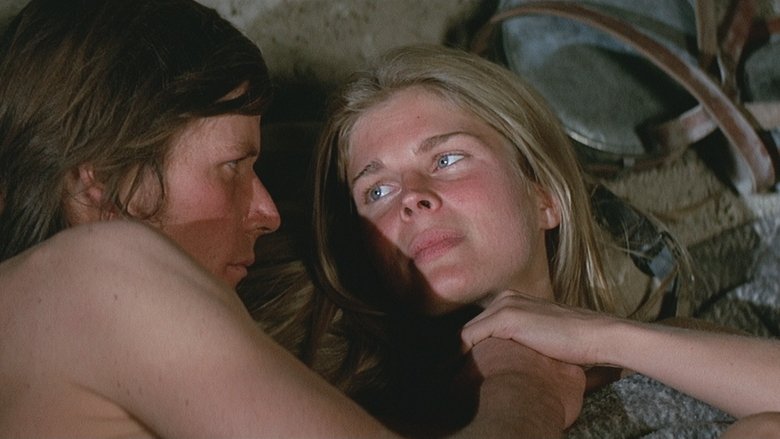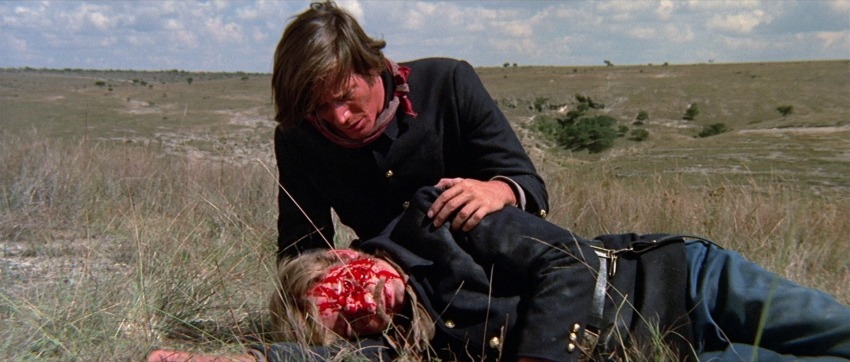← Back to Reviews

in

I consider myself a pretty hardened viewer when it comes to onscreen violence. It would be pretty hard to sustain an interest in horror and exploitation were I squeamish. But Soldier Blue bothered me in this respect. I mean this in a good way. This is a movie about the Sand Creek massacre, and the climax depicts the event in unflinching detail. The opening scene, where the Cheyenne attack a paymaster's escort, hints at the level of violence to come, but doesn't fully prepare us for the bracing impact of the massacre. Certainly, I can't think of a movie where this many women and children are murdered, and in such nauseating detail, being subject to headshots, decapitations and disembowelments, which the camera captures with perfect clarity. (The handsome cinematography makes the violence more startling as well. One would normally expect such gruesome images in a dingier presentation.) One might take issue with the splatter movie gusto with which this is delivered, but I think there's a certain integrity here, matching horrific events with horrific images. I understand the version released into theatres had twenty minutes of even more gruesome violence cut out. From the sounds of it, it would have made the movie play like Cannibal Ferox and the like. Would it have been too much? Perhaps for most viewers, but I can respect when a movie goes all out.
Outside these scenes however, the movie fumbles. Now, I don't expect a fifty year old Hollywood movie to measure up to modern notions of onscreen representation, and I do think there's a way to make a movie about historical injustices towards Native Americans framed through a white perspective. (I know there's been a lot of discussion in recent years about who should be allowed to tell what stories. It's a tricky subject, and I'm sympathetic to arguments on different sides of the debate, but I do find it sometimes gets conflated with the subject of representation in front of and behind the camera.) The bigger problem here is that there are none of the Native Americans in the movie are actual characters. We're supposed to feel for their plight, but the movie never bothers to engage with them as actual human beings, just plot points and ultimately victims. The final scenes are ugly and unpleasant enough that they make the point the movie pushes, but the surrounding film doesn't do much of the heavy lifting, and I can see why some found the movie ultimately dehumanizing. (While I alluded to this debate being somewhat modern, it was interesting to see that Ebert had the same criticisms in his review.) This movie was intended as an allegory for the Vietnam War, and specifically evokes the My Lai Massacre, but its distance makes this dimension ring hollow as well. (In contrast, I think of The Beast of War, an underrated war movie about the Soviet invasion of Afghanistan, and how that movie functions as a Vietnam allegory by having us directly identify both with Afghans, with their dialogue entirely in Pashto, and the Soviet aggressors, even as they commit war crimes.)
In between the violence of the opening and climactic scenes, the follows two white survivors from the opening attack: a greenhorn Union soldier played by Peter Strauss and a woman played by Candice Bergen who was formerly married to a Cheyenne leader. The tone of their scenes is oddly humorous, like the dynamic between Robert Redford and Jane Fonda in Barefoot in the Park. I like that movie, and I didn't find these scenes entirely uninvolving, but they strained the movie's credibility. Bergen gives speech after speech about injustices towards Native Americans (again, in place of us spending much time with any of them), and her overall vibe is that of a hippie chick, not someone who may have plausibly lived in the 1860s. Meanwhile, Strauss is so inept and clumsy that it's hard to buy him as a soldier, even an inexperienced one. One would have guessed he'd shot his foot off in basic training or something, and Bergen spends the majority of the movie saving his ass in all manner of situations. (Of course they get at least one extremely '70s-style montage.) It's worth noting that all of this is exquisitely shot by Robert B. Hauser, who until this point had mostly worked in television. (The following year he would work on Le Mans, the Steve McQueen movie which translated a Formula 1 race into pure feeling.) Anyway, it's a shame that the movie is largely a mess, because it is fairly well intentioned despite its failings, and worth seeing on the strength of the climax.
Soldier Blue (Nelson, 1970)

I consider myself a pretty hardened viewer when it comes to onscreen violence. It would be pretty hard to sustain an interest in horror and exploitation were I squeamish. But Soldier Blue bothered me in this respect. I mean this in a good way. This is a movie about the Sand Creek massacre, and the climax depicts the event in unflinching detail. The opening scene, where the Cheyenne attack a paymaster's escort, hints at the level of violence to come, but doesn't fully prepare us for the bracing impact of the massacre. Certainly, I can't think of a movie where this many women and children are murdered, and in such nauseating detail, being subject to headshots, decapitations and disembowelments, which the camera captures with perfect clarity. (The handsome cinematography makes the violence more startling as well. One would normally expect such gruesome images in a dingier presentation.) One might take issue with the splatter movie gusto with which this is delivered, but I think there's a certain integrity here, matching horrific events with horrific images. I understand the version released into theatres had twenty minutes of even more gruesome violence cut out. From the sounds of it, it would have made the movie play like Cannibal Ferox and the like. Would it have been too much? Perhaps for most viewers, but I can respect when a movie goes all out.
Outside these scenes however, the movie fumbles. Now, I don't expect a fifty year old Hollywood movie to measure up to modern notions of onscreen representation, and I do think there's a way to make a movie about historical injustices towards Native Americans framed through a white perspective. (I know there's been a lot of discussion in recent years about who should be allowed to tell what stories. It's a tricky subject, and I'm sympathetic to arguments on different sides of the debate, but I do find it sometimes gets conflated with the subject of representation in front of and behind the camera.) The bigger problem here is that there are none of the Native Americans in the movie are actual characters. We're supposed to feel for their plight, but the movie never bothers to engage with them as actual human beings, just plot points and ultimately victims. The final scenes are ugly and unpleasant enough that they make the point the movie pushes, but the surrounding film doesn't do much of the heavy lifting, and I can see why some found the movie ultimately dehumanizing. (While I alluded to this debate being somewhat modern, it was interesting to see that Ebert had the same criticisms in his review.) This movie was intended as an allegory for the Vietnam War, and specifically evokes the My Lai Massacre, but its distance makes this dimension ring hollow as well. (In contrast, I think of The Beast of War, an underrated war movie about the Soviet invasion of Afghanistan, and how that movie functions as a Vietnam allegory by having us directly identify both with Afghans, with their dialogue entirely in Pashto, and the Soviet aggressors, even as they commit war crimes.)
In between the violence of the opening and climactic scenes, the follows two white survivors from the opening attack: a greenhorn Union soldier played by Peter Strauss and a woman played by Candice Bergen who was formerly married to a Cheyenne leader. The tone of their scenes is oddly humorous, like the dynamic between Robert Redford and Jane Fonda in Barefoot in the Park. I like that movie, and I didn't find these scenes entirely uninvolving, but they strained the movie's credibility. Bergen gives speech after speech about injustices towards Native Americans (again, in place of us spending much time with any of them), and her overall vibe is that of a hippie chick, not someone who may have plausibly lived in the 1860s. Meanwhile, Strauss is so inept and clumsy that it's hard to buy him as a soldier, even an inexperienced one. One would have guessed he'd shot his foot off in basic training or something, and Bergen spends the majority of the movie saving his ass in all manner of situations. (Of course they get at least one extremely '70s-style montage.) It's worth noting that all of this is exquisitely shot by Robert B. Hauser, who until this point had mostly worked in television. (The following year he would work on Le Mans, the Steve McQueen movie which translated a Formula 1 race into pure feeling.) Anyway, it's a shame that the movie is largely a mess, because it is fairly well intentioned despite its failings, and worth seeing on the strength of the climax.
